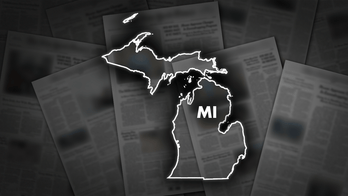
Oct. 2, 2013: A man looks over the Affordable Care Act (commonly known as Obamacare) signup page on the HealthCare.gov website. (Reuters)
As the Obama administration touts its latest enrollment numbers for the ObamaCare exchanges, some state networks are grappling with major changes ahead of the next sign-up period – meaning more cost to taxpayers.
The biggest overhaul came out of Oregon, which last week decided to junk its broken health care exchange and turn to the federal government for help.
"Their health exchange has been a disaster,” said Michael Cannon, of the Cato Institute.
"They're the only state in the country that built their own exchange and couldn't get it to a level of functionality to sign a single person up,” said Jim Capretta, of the Ethics and Public Policy Center.
But Oregon isn’t the only state still struggling, months after the major problems with HealthCare.gov were addressed.
Systems in Vermont, Massachusetts, Nevada and Maryland continue to have problems.
"The federal government spent about a billion dollars on those five state exchanges, and none of them are very likely to work well ever,” Capretta said. “So that's a lot of wasted taxpayer money."
Maryland's exchange imploded, and it decided a month ago to adopt the system used by Connecticut. But officials say they’ll need $40-50 million more to cover the costs.
Officials refuse to say where the money will come from, but taxpayers somewhere will pay.
In all, the state exchanges cost taxpayers almost $4.2 billion to build,and will cost even more to fix.
Meanwhile, the administration reported updated figures Thursday showing more than 8 million signed up in the first enrollment period.
But Republicans in Congress cast doubt on the figures in a report a day earlier, putting out estimates they claim show how many people actually paid their first month’s premiums.
The House Energy and Commerce Committee said, based on information from insurance providers in the federal exchange, only 67 percent of people who selected a plan on HealthCare.gov had paid their first premium as of April 15.
“Now what we don't know is how many of those have continued to make that payment and are successfully enrolled," noted Rep. Marsha Blackburn, R-Tenn.
The information from Republicans came from contacting 160 insurance companies listed on HealthCare.gov and getting payment rates as of April 15.
The administration argues some didn't have to pay until May 1 and several insurers have reported higher payment numbers.
"It doesn't match with public comments by insurance company executives, most of which have indicated that they're seeing 80 to 90 percent of their enrollees pay their premiums,” White House Press Secretary Jay Carney said Thursday.
Blackburn said even if that were true, it would be nothing to brag about. "If you were a business owner, and you had accounts receivable, and 20 percent of your accounts on a monthly basis did not pay their bill, you'd say we've got a problem here."




